Which of the following is an example of a population?
A.a spider and the fly it is about to eat
B.the earthworms
that live in a grassland plus the earthworms that live in a
forest
C.all of the redwood trees that live in a
forest
D.all the plants that live near each other in a
forest
E.all the coyotes on Earth
C
To determine the density of a rabbit population, you would need to know the number of rabbits and _____.
A.their pattern of dispersion
B.the size of the area in which
they live
C.the birth rate
D.the factors that limit
population growth for that rabbit population
E.the growth rate of
the population
B
In wild populations, individuals most often show a _____ pattern of dispersion.
A.random
B.equilibrium
C.density-dependent
D.clumped
E.uniform
D
x/n=s/N or, solving for population size, N=sn/x
Suppose that none of the 44 dolphins encountered in the second
sampling had been photographed before.
Would you be able to solve
the equation for N? What might you conclude about population size in
this case?
A.The equation can be solved, and you would conclude that the
population size is very small.
B.The equation cannot be solved,
but you would conclude that the population size is very
large.
C.The equation can be solved, and you would conclude that
the population size is close to 1,100.
D.The equation cannot be
solved, so you would not be able to reach any conclusions about
population size.
B
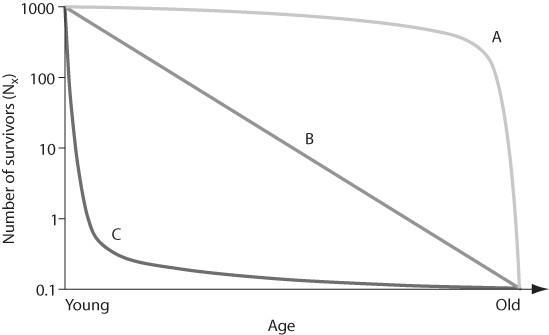
In the figure above, which of the following survivorship curves implies that an animal may lay many eggs, of which a regular number die each year on a logarithmic scale?
A.curve A
B.curve B
C.curve C
B
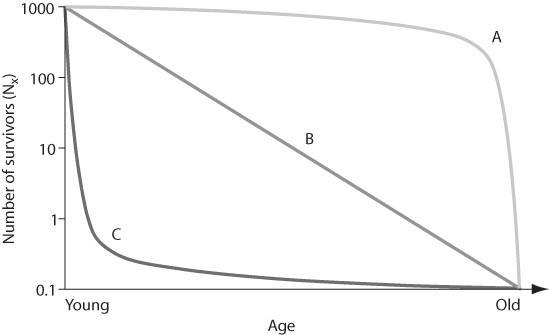
In the figure above, which of the following survivorship curves most applies to humans living in developed countries?
A.curve A
B.curve B
C.curve C
D.curve A or curve B
A
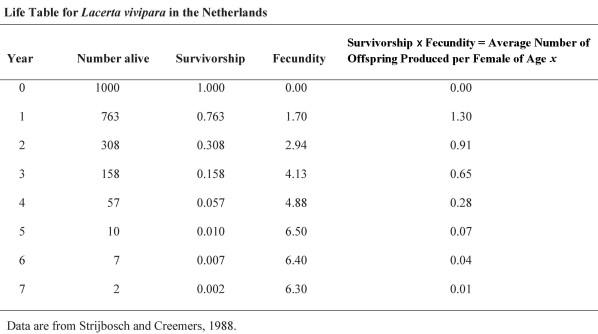
Using the table above, how would you describe the population dynamics of L. vivipara?
A.The population is stable.
B.The population is
decreasing.
C.The population is increasing.
D.The figure
does not provide this information.
C
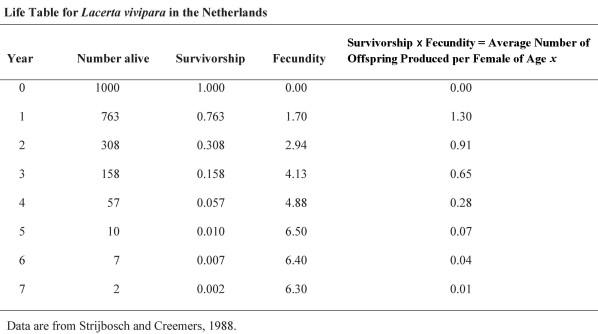
Using the table above, determine which age class year would hurt the population growth most if it were wiped out by disease.
A.age class year 1
B.age class year 2
C.age class year
3
D.age class year 4
A
Suppose researchers marked 800 turtles and later were able to trap a total of 300 individuals in that population, of which 150 were marked. What is the estimate for total population size?
A.1600
B.200
C.1050
D.2100
A
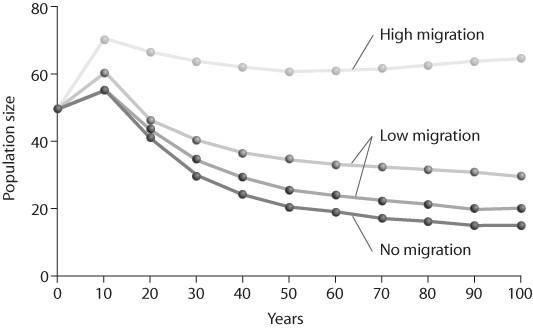
Looking at the figure above, what is contributing significantly to
stabilizing population size over time?
I) no migration
II)
low migration
III) high migration
A.only I
B.only II
C.only III
D.only II and III
C
Which of the following assumptions have to be made regarding the
mark-recapture estimate of population size?
I) Marked and
unmarked individuals have the same probability of being
trapped.
II) The marked individuals have thoroughly mixed with
the population after being marked.
III) No individuals have
entered or left the population by immigration or emigration, and no
individuals have been added by birth or eliminated by death during the
course of the estimate.
A.I only
B.II only
C.I and II only
D.I, II, and III
D
Which of the following is the most important assumption for the mark-recapture method to estimate the size of wildlife populations?
A.Marked individuals have the same probability of being recaptured
as unmarked individuals during the recapture phase.
B.There is a
50:50 ratio of males to females in the population before and after
trapping and recapture.
C.More individuals emigrate from, as
opposed to immigrate into, a population.
D.Over 50% of the marked
individuals need to be trapped during the recapture phase.
A
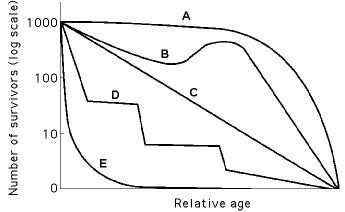
Refer to the figure above. Which curve best describes survivorship in marine molluscs?
A.A
B.B
C.C
D.E
D
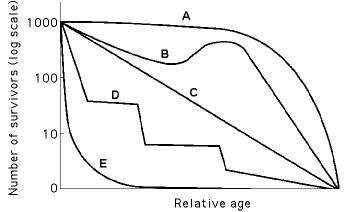
Refer to the figure above. Which curve best describes survivorship in elephants?
A.A
B.B
C.C
D.E
A
Long-term studies of Belding's ground squirrels show that immigrants move nearly 2 kilometers from where they are born and become 1%-8% of the males and 0.7%-6% of the females in other populations. On an evolutionary scale, why is this significant?
A.These immigrants provide a source of genetic diversity for the
other populations.
B.Those individuals that emigrate to these new
populations are looking for less crowded conditions with more
resources.
C.These immigrants make up for the deaths of
individuals, keeping the other populations' size
stable.
D.Gradually, the populations of ground squirrels will
move from a clumped to a uniform population pattern of dispersion.
A
A population is correctly defined as having which of the following
characteristics?
I) inhabiting the same general area
II)
belonging to the same species
III) possessing a constant and
uniform density and dispersion
A.III only
B.I and II only
C.II and III only
D.I,
II, and III
B
An ecologist recorded twelve white-tailed deer, Odocoileus virginianus, per square kilometer in one woodlot and twenty per square kilometer in another woodlot. What was the ecologist comparing?
A.range
B.density
C.dispersion
D.carrying capacity
B
Which of the following groups would be most likely to exhibit uniform dispersion?
A.lake trout, which seek out cold, deep water high in dissolved
oxygen
B.cattails, which grow primarily at edges of lakes and
streams
C.dwarf mistletoes, which parasitize particular species
of forest tree
D.red squirrels, who actively defend territories
D
Which of the following examples would most accurately measure the density of the population being studied?
A.counting the number of times a one-kilometer transect is
intersected by tracks of red squirrels after a
snowfall
B.counting the number of zebras from airplane census
observations.
C.counting the number of moss plants in
one-square-meter quadrants
D.counting the number of coyote
droppings per hectare
C
Which of the following is the best natural example of uniform distribution?
A.snails in an intertidal zone at low tide
B.bees collecting
pollen in a wildflower meadow
C.territorial songbirds in a mature
forest during mating season
D.mushrooms growing on the floor of
an old growth forest
C
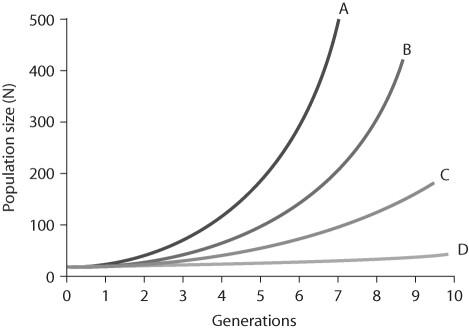
In the figure above, which of the lines represents the highest per-capita rate increase (r)?
A.line D
B.line A
C.line B
D.line C
B
Starting from a single individual, what is the size of a population of bacteria at the end of a two-hour time period if they reproduce by binary fission every twenty minutes? (Assume unlimited resources and no mortality.)
A.128
B.64
C.32
D.16
B
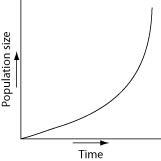
Which of the following graphs illustrates the population growth curve of single bacterium growing in a flask of ideal medium at optimum temperature over a two-hour period?
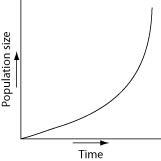
During exponential growth, a population always _____.
A.grows at its maximum per capita rate
B.cycles through
time
C.loses some individuals to emigration
D.quickly
reaches its carrying capacity
A
Consider two old-growth forests: one is undisturbed while the other is being logged. In which region are species likely to experience exponential growth, and why?
A.Logged, because the various populations are stimulated to a
higher reproductive potential.
B.Old growth, because of stable
conditions that would favor exponential growth of all species in the
forest.
C.Logged, because the disturbed forest affords more
resources for increased specific populations to grow.
D.Old
growth, because each of the species is well established and can
produce many offspring.
C
The number of individuals that a particular habitat can support with no degradation of that habitat is called _____.
A.carrying capacity
B.community
C.niche
D.biotic potential
E.survivorship
A
Imagine that you are managing a large game ranch. You know from historical accounts that a species of deer used to live there, but they have been extirpated. After doing some research to determine what might be an appropriately sized founding population, you reintroduce them. You then watch the population increase for several generations, and graph the number of individuals (vertical axis) against the number of generations (horizontal axis). With no natural predators impacting the population, the graph will likely appear as _____.
A.a diagonal line, getting higher with each generation
B.an
upside-down "U"
C.a "J," increasing with each
generation
D.an "S" that ends with a vertical line
C
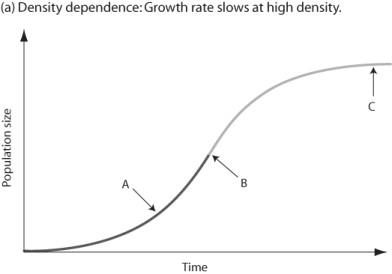
In the figure above, which of the arrows represents the carrying capacity?
A.arrow A
B.arrow B
C.arrow C
D.Carrying capacity
cannot be found in the figure because species under density-dependent
control never reach carrying capacity.
C
Which statements about K are correct?
I) K varies among
populations.
II) K varies in space.
III) K varies in
time.
IV) K is constant for any given species.
A.only I and III
B.only I, II, and III
C.only II and
IV
D.only II, III, and IV
B
As N approaches K for a certain population, which of the following is predicted by the logistic equation?
A.The growth rate will approach zero.
B.The growth rate will
not change.
C.The carrying capacity of the environment will
increase.
D.The population will increase exponentially.
A
Which of the following causes populations to shift most quickly from an exponential to a logistic population growth?
A.decreased death rate
B.favorable climatic
conditions
C.removal of predators
D.competition for resources
D
According to the logistic growth equation, (dn/dt) = rmaxN(K-N)/K
A.the per capita growth rate (r) increases as N approaches
K.
B.the number of individuals added per unit time is greatest
when N is close to zero.
C.population growth is zero when N
equals K.
D.the population grows exponentially when K is small.
C
Which of the following conditions favors "big-bang" reproduction?
A.high levels of parental care
B.intense intraspecific
competition
C.predictable physical environment
D.low rates
of offspring survival
E.high rate of offspring survival
D
Which of the following is regarded as a density-independent factor in the growth of natural populations?
A.intraspecific competition
B.predation
C.interspecific competition
D.emigration
E.flooding
E
What is the primary limiting factor that determines why no female animal can produce a very large number of very large eggs?
A.Time is limited.
B.There will be an increase in predation
pressure if the females carry too many large eggs.
C.There are
energy constraints.
D.Temperature constraints will prevent
females from carrying too many eggs.
C
Based on the figure above, which of the following statements correctly interprets the data?
A.Clutch size decreases as female density increases.
B.As
female density increases, clutch size increases.
C.As female
density increases, survivorship decreases.
A
Natural selection involves energetic trade-offs between _____.
A.high survival rates of offspring and the cost of parental
care
B.choosing how many offspring to produce over the course of
a lifetime and how long to live
C.increasing the number of
individuals produced during each reproductive episode and a
corresponding decrease in parental care
D.producing large numbers
of gametes when employing internal fertilization versus fewer numbers
of gametes when employing external fertilization
A
Which of the following is characteristic of K-selected populations?
A.a high intrinsic rate of increase
B.offspring with good
chances of survival
C.many offspring per reproductive
episode
D.small offspring
B
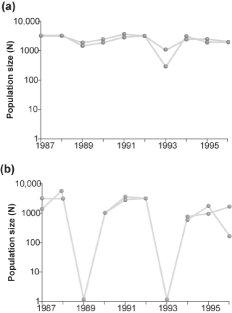
Graph (b) in the figure above shows the normal fluctuations of a population of grouse. Assuming graph (a) in the figure above is the result of some experimental treatment in the grouse population, what can be concluded?
A.The experimental treatment exacerbated the population
cycling.
B.The experimental treatment has most likely identified
the cause of population cycling.
C.The experimental treatment did
not affect population cycling in this species.
D.None of the
other responses is true.
B
Resource competition, territoriality, disease, and toxic wastes are some of the factors that provide _____ and help regulate population.
A.metapopulations
B.negative feedback
C.zero population
growth
D.population dynamics
E.positive feedback
B
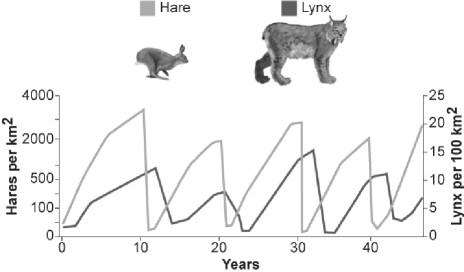
What conclusion can you draw from the figure above?
A.Hares control lynx population size.
B.Lynx and hare
populations are independent of each other.
C.Lynx control hare
population size.
D.The relationship between the populations
cannot be determined only from this graph.
D

Looking at the data in the figure above from the hare/lynx
experiment, what conclusion can you draw?
I) Food is a factor in
controlling hare population size.
II) Excluding lynx is a factor
in controlling hare population size.
III) The effect of excluding
predators and adding food in the same experiment is greater than the
sum of excluding lynx alone plus adding food alone.
A.only I
B.only II
C.only III
D.I, II, and III
D
A population of white-footed mice becomes severely overpopulated in a habitat that has been disturbed by human activity. Sometimes intrinsic factors cause the population to increase in mortality and lower reproduction rates to occur in reaction to the stress of overpopulation. Which of the following is an example of intrinsic population control?
A.All of the resources (food and shelter) are used up by
overpopulation, and much of the population dies of exposure and/or
starvation.
B.Clumped dispersion of the population leads to
increased spread of disease and parasites, resulting in a population
crash.
C.Owl populations frequent the area more often because of
increased hunting success.
D.Females undergo hormonal changes
that delay sexual maturation, and many individuals suffer depressed
immune systems and die due to the stress of overpopulation.
D
Ignoring migration, the age structure of a human population likely to increase in size will have what shape?
A.Both a pyramid and a rectangle tapering toward the top result in
a population that increases in size.
B.Both an inverted pyramid
and a rectangle tapering toward the top result in a population that
increases in size.
C.inverted pyramid
D.a rectangle tapering
toward the top
E.pyramid
E
Ignoring migration, the age structure of a human population likely to decrease in size will have what shape?
A.a rectangle tapering toward the top
B.inverted
pyramid
C.Both an inverted pyramid and a rectangle tapering
toward the top result in a population that decreases in
size.
D.pyramid
E.Both a pyramid and a rectangle tapering
toward the top result in a population that decreases in size.
B
Ignoring migration, the age structure diagram of a human population likely to maintain a relatively stable size will have what shape?
A.Both a pyramid and a rectangle tapering toward the top result in
a population that remains stable in size.
B.a rectangle tapering
toward the top
C.inverted pyramid
D.pyramid
E.Both an
inverted pyramid and a rectangle tapering toward the top result in a
population that remains stable in size.
B
What are population dynamics?
A.Number of individuals born each year in a
population.
B.Proportion of individuals at each possible
age.
C.Regular fluctuations in the population size of some
animals.
D.Changes in populations through time.
D
Which of the following statements about age pyramids is true?
A.Populations in developed countries grow more quickly than
populations in less-developed countries.
B.Predictions of a
population's future take into account such factors as increasing
survivorship and fecundity levels that remain the same.
C.Age
distribution in less-developed countries is bottom-heavy, indicating
that these populations are dominated by the very old.
D.Age
distribution in developed countries shows an hourglass pattern, with
the greatest numbers of people being either very young or very old.
B
True or false? The growth rate of a certain population increases very quickly for a time and then levels off to zero. The most likely reason that the growth rate leveled off to zero is that the environment reached its carrying capacity.
A.True
B.False
A
The average age of childbearing in country A is 26, whereas the average age in country B is 30. In each country, the average number of offspring per woman is 3. Which of the following statements about the population growth rate in each country must be true?
A.The population growth rate in country A is lower than in country
B.
B.It is not possible to compare the population growth rates of
countries A and B.
C.The population growth rate in country A is
higher than in country B.
D.The population growth rates in
countries A and B are the same.
B
In 1970, the average age of childbearing was 28, and the average number of offspring per woman was 3 in a certain country. In 1980, the average age of childbearing was still 28, but the average number of offspring per woman was 2 in that country. If the death rate in the country remained constant during those years, how did the population growth rate change from 1970 to 1980?
A.The population growth rate stayed the same.
B.The population
growth rate increased.
C.The population growth rate
decreased.
D.It is not possible to determine the population
growth rate.
C
A broad-based pyramid-shaped age structure is characteristic of a population that is _____.
A.limited by density-dependent factors
B.growing
rapidly
C.stable
D.shrinking
E.at carrying capacity
B
Which of the following is the most accurate statement on Earth's carrying capacity for humans?
A.When it comes to humans, the concept of K is
irrelevant.
B.The human population has already exceeded
K.
C.Our technology has allowed the human population to keep
increasing K.
D.The human population is still a long way from
K.
E.K is smaller now than it was a thousand years ago.
C
A recent study of ecological footprints concluded that _____.
A.it is not possible for technological improvements to increase
Earth's carrying capacity for humans
B.the ecological footprint
of the United States is large because per capita resource use is
high
C.current demand by industrialized countries for resources
is much smaller than the ecological footprint of those
countries
D.Earth's carrying capacity would increase if per
capita meat consumption increased
B
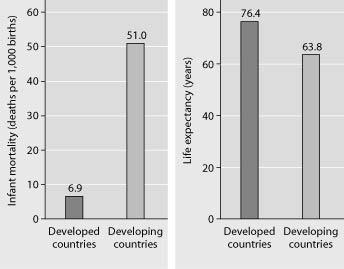
What is a logical conclusion that can be drawn from the graphs above? Developed countries have _____.
A.lower infant mortality rates and lower life expectancy than
developing countries
B.lower infant mortality rates and higher
life expectancy than developing countries
C.higher infant
mortality rates and lower life expectancy than developing
countries
D.higher infant mortality rates and higher life
expectancy than developing countries
B
Why does the 2009 U.S. population continue to grow even though the United States has essentially established a zero population growth (ZPG)?
A.emigration
B.baby boomer
reproduction
C.immigration
D.the 2007-2009 economic recession
C